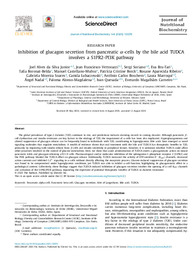Please use this identifier to cite or link to this item:
https://hdl.handle.net/11000/38547Full metadata record
| DC Field | Value | Language |
|---|---|---|
| dc.contributor.author | Alves da Silva Junior, Joel | - |
| dc.contributor.author | Vettorazzi, Jean Franciesco | - |
| dc.contributor.author | Soriano, Sergi | - |
| dc.contributor.author | Bru-Tari, Eva | - |
| dc.contributor.author | Boronat-Belda, Talía | - |
| dc.contributor.author | Castellano-Muñoz, Manuel | - |
| dc.contributor.author | Borck, Patrícia Cristine | - |
| dc.contributor.author | Ribeiro, Rosane Aparecida | - |
| dc.contributor.author | Soares, Gabriela Moreira | - |
| dc.contributor.author | Lubaczeuski, Camila | - |
| dc.contributor.author | Boschero, Antonio Carlos | - |
| dc.contributor.author | Marroqui Esclapez, Laura | - |
| dc.contributor.author | Nadal, Angel | - |
| dc.contributor.author | Alonso Magdalena, Paloma | - |
| dc.contributor.author | Quesada, Ivan | - |
| dc.contributor.author | Magalhaes Carneiro, Everardo | - |
| dc.contributor.other | Departamentos de la UMH::Fisiología | es_ES |
| dc.date.accessioned | 2025-11-27T13:18:02Z | - |
| dc.date.available | 2025-11-27T13:18:02Z | - |
| dc.date.created | 2025 | - |
| dc.identifier.citation | The Journal of Nutritional Biochemistry | es_ES |
| dc.identifier.issn | 1873-4847 | - |
| dc.identifier.issn | 0955-2863 | - |
| dc.identifier.uri | https://hdl.handle.net/11000/38547 | - |
| dc.description.abstract | The global prevalence of type 2 diabetes (T2D) continues to rise, and predictions indicate alarming records in coming decades. Although pancreatic β-cell dysfunction and insulin resistance are key factors in the etiology of T2D, the impairment of α-cells has been also implicated. Hyperglucagonemia and altered suppression of glucagon release can be frequently found in individuals with T2D, contributing to hyperglycemia. Bile acids have emerged as novel signaling molecules that regulate metabolism. A wealth of evidence shows that oral treatment with the bile acid TUDCA has therapeutic benefits in T2D, primarily by improving both insulin release from β-cells and insulin sensitivity in peripheral tissues. However, it is unknown whether TUDCA could affect other processes involved in the control of glucose metabolism. Here, we show that acute administration of TUDCA exerts a glucagonstatic action on mouse pancreatic islets and glucagon-releasing αTC1-9 cells. Pharmacological and/or molecular inhibition of the sphingosine-1-phosphate receptor 2 (S1PR2) and the PI3K pathway blunted the TUDCA effect on glucagon release. Additionally, TUDCA increased the activity of ATP-sensitive K+ (KATP) channels, decreased action currents and inhibited Ca2+ signaling in α-cells without directly affecting the exocytotic process. Glucose-induced suppression of glucagon secretion was found to be compromised under hyperglycemic conditions, yet TUDCA was able to inhibit α-cell function, highlighting its glucagonstatic effect in a pathological context. Collectively, these findings suggest that TUDCA-induced inhibition of glucagon secretion involves the opening of α-cell KATP channels and activation of the S1PR2/PI3K pathway, expanding the repertoire of potential therapeutic benefits of TUDCA in diabetes treatment. | es_ES |
| dc.format | application/pdf | es_ES |
| dc.format.extent | 10 | es_ES |
| dc.language.iso | spa | es_ES |
| dc.publisher | Elsevier | es_ES |
| dc.relation.ispartofseries | 146 | es_ES |
| dc.rights | info:eu-repo/semantics/openAccess | es_ES |
| dc.rights | Attribution-NonCommercial-NoDerivatives 4.0 Internacional | * |
| dc.rights.uri | http://creativecommons.org/licenses/by-nc-nd/4.0/ | * |
| dc.subject | Pancreatic alpha-cell | es_ES |
| dc.subject | Pancreatic beta-cell | es_ES |
| dc.subject | Glucagon secretion | es_ES |
| dc.subject | Islet of Langerhans | es_ES |
| dc.subject | Bile acid | es_ES |
| dc.subject | TUDCA | es_ES |
| dc.subject.other | CDU::6 - Ciencias aplicadas::61 - Medicina::612 - Fisiología | es_ES |
| dc.title | Inhibition of glucagon secretion from pancreatic α-cells by the bile acid TUDCA involves a S1PR2-PI3K pathway | es_ES |
| dc.type | info:eu-repo/semantics/article | es_ES |
| dc.relation.publisherversion | https://doi.org/10.1016/j.jnutbio.2025.110076 | es_ES |

View/Open:
1_2025_Inhibition of glucagon secretion from pancreatic α-cells by the bile acid TUDCA involves a S1PR2-PI3K pathway.pdf
2,16 MB
Adobe PDF
Share:
.png)
